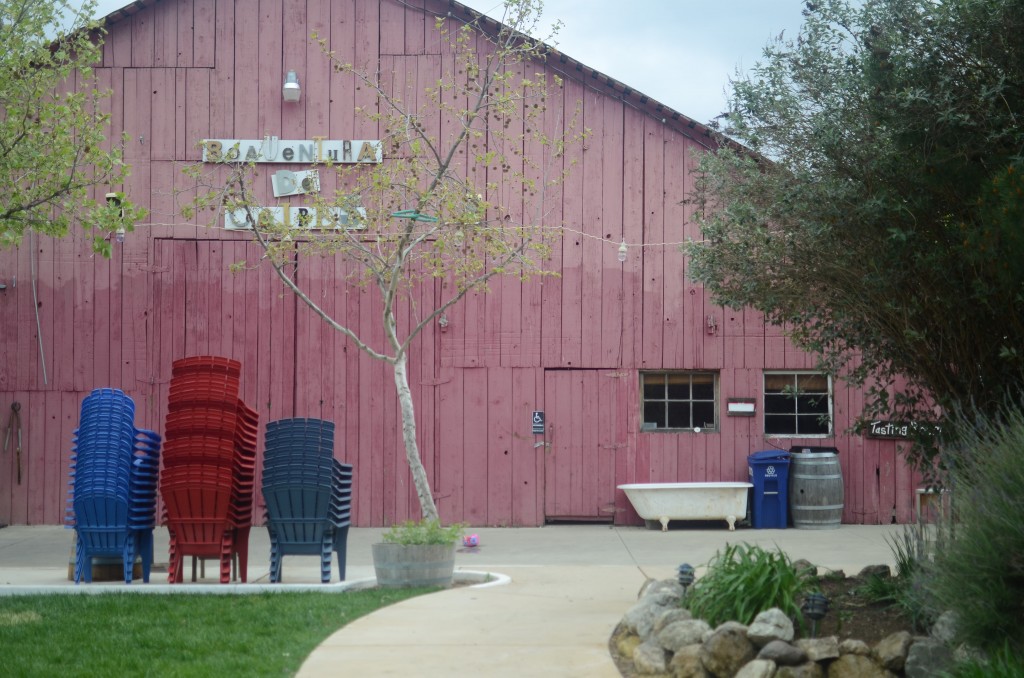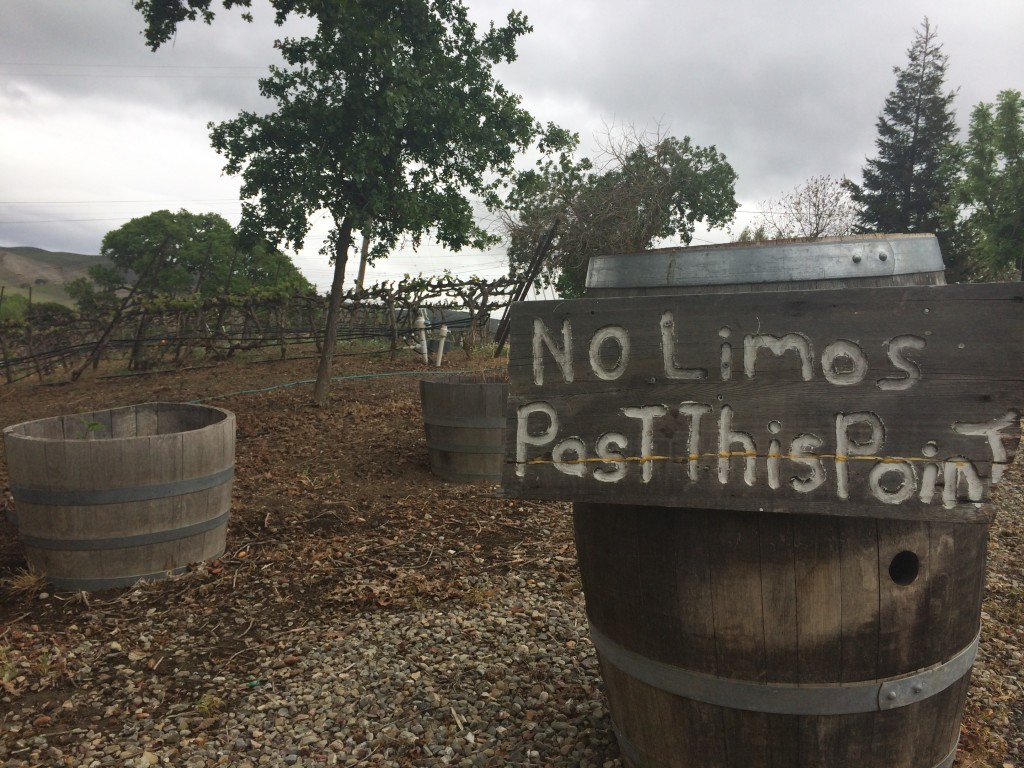“Handcrafted” has become such a buzzword in the wine industry that it’s almost meaningless, superfluous. But not at BoaVentura de Caires, the Livermore Valley winery owned by Brett Caires. His operation is truly handcrafted.
Brett planted the vineyards and renovated the horse corral that’s now his winery and tasting room almost wood plank by wood plank. He salvaged redwood, a couple of stained glass windows and a door from buildings on the nearby Concannon Vineyard property that were being demolished. And, oh yeah, Brett farms the vineyards and makes the wine. His hands are on every grape cluster, every vat of fermenting grape juice, every barrel of aging wine, every bottle filled and dipped in wax.
BoaVentura is not your typical winery, and that’s what makes it such a wonderful place to visit. When you pull up the steep driveway, you see a sign that says “No limos past this point.” Brett means it. He tells the story of a limo driver who ignored the warning and got his vehicle stuck against an oak tree.
Upon your arrival, you’ll hear roosters crowing, several vineyard dogs and a bunch of children running around. He calls them his “rat pack,” and three of them belong to him and his wife. His son proudly carries an a giant egg in his shirt. There’s a big lawn in front of the bright red winery barn, with a chicken coup, raised garden beds and picnic tables. The setting is quaint and authentic. Authenticity is what Brett is all about.
When it comes to winemaking, Brett’s approach is distinctly handcrafted too. Everything is done by gravity flow. During harvest and crush he punches down caps with his own hands on up to 30 bins of fermenting wine four times a day for three weeks. That is some daily workout during harvest. He hand bottles, hand labels, and hand dips the wine bottle tops in wax.
Once you’re inside the tasting room, it’s a visual feast for your eyes. There’s the 100 year old barber poll that stood outside his wife’s father’s barber shop. Hanging on the wall, the first dollar he made selling wine. Photographs show the ranch the day he bought it in 1999. “It came with 14 sheep, four goats, a donkey, 30 geese and 20 chickens,” Brett says. “It was a complete train wreck, an abandoned goat farm.”
There’s even a photo of Brett on his 35th birthday planting vine number 5000.
Brett launched BoaVentura de Caires in 2000 and opened his tasting room in 2005. The winery takes its name from Brett’s grandfather who immigrated from the Portuguese island of Madeira in 1915 at the age of 13. “His name BoaVentura means ‘good fortune.’” I met Brett not long after he opened his tasting room shooting a story for the NBC TV show I produced, In Wine Country. That day he was making a bench for outside the tasting room and bottling one of his Cabernets. It was all by hand then and still is today. Brett’s had the “good fortune” of selling out every vintage. He’s up to what he considers full capacity, 2000 cases, and is happy to stay at that size.
Before becoming a hands-on vintner, Brett was a real estate broker and still has his license. He’s also a chef and loves to cook. He recently catered an auction dinner for a neighboring winery, and he cooks for some of his wine club events. Talk about multitalented.
Thanks to his Portuguese grandparents Brett grew up around wine. “My grandmother would cook lunch and you’d always have a glass of milk and some apricot brandy or port.”
While most of his wines are Cabernet Sauvignon, Brett does make two wines in homage to his Portuguese roots. One is the only white wine he makes. “I mimic the Vinho Verde from Portugal so it’s slightly effervescent, but it’s a dry, super refreshing summer wine.” The blend is Albariño grapes from Livermore and the Mokelumne River AVA (near Lodi), Livermore Sauvignon Blanc and a little Orange Muscat from Quady in Madera. This is one of my favorite whites coming out of Livermore, fragrant, with white flowers, citrus and a little stone fruit and honey.
The other is is “Deported” Port, made in the traditional Ruby style, aged a minimum of five years in barrel. The 2008 vintage is a Cabernet Port, but Brett has planted the traditional Port grapes – Touriga Nacional, Touriga Souza, Tinta Cao and Tinta Amarilla – around the perimeter of his vineyards. Soon, his Ports will be made with these grapes. Brett also put away half of the 2008 Port to age as a Tawny Port, which he plans to release in 2015.
The label on the Port is a copy of his great grandfather’s passport, with picture, in Portuguese. His great grandfather accompanied Brett’s grandfather immigrating in 1917. But, Brett says, “my great grandfather Antonio gets deported for making bootleg wine in Oakland.” He liked the play on the word “deported.” The TTB, the government agency that regulates alcohol and approves labels, wasn’t so keen on it. It took Brett two years to get the green light to use the label. “We were able to show that he got deported,” he says. “Then we had to get the passport translated from the old Portuguese to modern Portuguese to make sure were weren’t saying anything like screw the TTB.”
You get the feeling Brett likes to challenge authority and do things his own way, and you’d be right. In his tasting room he has a sign up about how he can’t serve cheese anymore due to what Brett [and fellow vintners] consider a ridiculous rule from the Alameda Country Health Department. It requires wineries serving anything but crackers — including olives or bread — to have a three compartment sink and a wash station. “It’s not like I’m making the cheese,” he says.
Brett also likes the fact that he’s completely self contained, completely self-sufficient. For example, he doesn’t bring in a mobile bottling truck because he doesn’t want his wine going through 50 pumps. “Everything gets a lot of love and I think it shows, I hope it shows.”
It does. Brett’s wine are beautiful and aromatic. Across the board the reds are silky, with velvety tannins, but very balanced when it comes to acid and alcohol. His style is bright acid, and he leans towards leaner, but recognizes he’s got customers who like richer wines too. He makes a beautiful Syrah, with a little Zinfandel blended in.
Perhaps Brett’s pride and joy are his Livermore Valley Cabernets — bottlings of grapes from what he calls his bottom and his upper vineyards on the ranch. His lightest style Cab is the Green Label, what Brett calls “Cab with training wheels. It’s for people who are first getting into Cab but don’t think they like Cab,” he says. “They like this and become addicted.” Green Label is 100% from the vineyard behind the tasting room, which is a sunny site.
BoaVentura’s Black Label Cabernet is an equal blend of that vineyard and the bottom vineyard, where temperatures are much cooler and has much rockier soils. “You’ll start to notice quite a bit more earth, leather and tobacco notes and heavier tannins,” Brett says.
Of all the Cabs he makes, Brett’s favorite to drink is the Maroon Label Cabernet Sauvignon. “It’s super austere,” he says. “It reminds me of the old world Pinot Noir style with that gym sock, mushroomy, earthy character.” The grapes for the Maroon wine all come from the bottom vineyard, made only when there are good vintages. He considers this his top flight wine.
Then there’s the Platinum Label Cabernet, a non-vintage wine that Brett makes when he doesn’t make the Maroon Label. Platinum is a blend of both upper and bottom vineyards. It is his favorite wine to make. “I get to tweak it and I get to have the most fun with it,” Brett says. The color is deep purple and concentrated. The last vintage was 2008, “super earthy and austere and that’s just the way I like it.” The wine has such a floral violet nose and it is as smooth as silk. “It should be after 30 months in barrel,” he says.
All of Brett’s reds see at least 20 to 22 months in oak barrel, a mixture of 25% new French and one to two year and neutral barrels. When he crushes, he doesn’t actually crush the grapes or the seeds, preferring whole berry fermentation. That’s how he gets such silky tannins.
To experience BoaVentura wines, you’ll need to visit the tasting room, which is open one weekend a month. It’s worth the trip, to soak up the atmosphere, hear the crowing roosters compete with Nirvana and Depeche Mode on the radio, and meet the man who’s making wine his own way, a truly handcrafted labor of love.
Photos by Jon Orlin



















